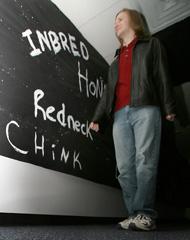The Inter-Residence Council organized and sponsored a Tunnel of Oppression exhibit in the basement of Turlington Residence Hall Tuesday and Wednesday.
The exhibit consisted of audio clips of various racial and derogatory names, videos and a number of facts concerning certain issues of oppression.
“The tunnel is an interactive museum,” Anna Patton, vice president of hall council affairs in IRC and a junior in psychology and Spanish, said. “It’s a museum for your senses.”
The IRC focused on the issues of racism, the homeless, bisexuals, gays, lesbians, immigration and Appalachian oppression.
The council had many other areas of concern they wanted to cover, such as domestic violence, religion, body mutilations and eating disorders, but Patton said the group lacked the resources to include all the issues.
However, Patton said she feels the exhibit still created a shock factor for students by making them aware of issues in today’s world.
“It appealed to emotions and humanity,” Patton said.
She said she hopes the tunnel will make students want to make a difference in the recognized issues.
“[It begins] with one person thinking about it, talking about it and doing something about it,” Patton said.
Some students who saw the exhibit said it changed the way they will live.
“I took away a new-found respect for the way my life is set up and a feeling of anger towards those who use oppressive words with no care at all,” Jeff Niski, a freshman in biochemistry, said.
He said he was appalled when he saw posters made by Christians protesting homosexuals with phrases like “AIDS is the cure for GAY.”
“It infuriated me that Christians would actually make signs like those and they would even represent the Christian community that way,” Niski said.
According to Niski, he felt the exhibit gave “a voice to all those who were oppressed all at once instead of focusing on the pain of one group while ignoring another.”
After seeing the exhibit, he was going to change his vocabulary and his actions around his friends, he said.
“I’ll become an activist for the ‘little guy’ if needed to stop this for good,” Niski said.
Kim Bell, a junior in anthropology, said she felt the exhibit was well-researched and planned.
“It really covered a lot of areas and issues with different types of oppression, and the variety of the ways in which they were displayed really got to you,” Bell said.
Erika Bowles, a resident director in Lee Hall and a master student in counselor education, said this exhibit was different from those at other universities because students were able to go through at their own pace, which allowed them to read all the facts displayed.
Bowles said one of the key points of the exhibit was to raise awareness for students who question, “How do I make an impact as an individual?”
The Tunnel of Oppression created a “safe space” for students to discuss ways they can help and what they can do, according to Bowles.
Patton said IRC hopes to continue to expand the Tunnel of Oppressionin future semesters.
“We hope to build and get bigger every year,” she said.








